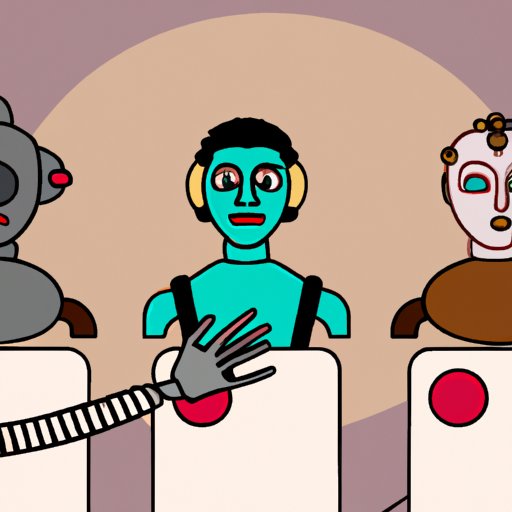Introduction
Robotics has become an increasingly important field of research and development in recent years, with the emergence of autonomous machines that are able to carry out a variety of tasks without direct human intervention. As robotic technology advances, it is essential to consider the ethical implications of these machines and how they will be programmed to interact with humans and other robots. One of the most important frameworks for understanding the ethical implications of robotics is the Three Laws of Robotics, which were first introduced by Isaac Asimov in his 1942 short story collection I, Robot.
This article will explore the history of the Three Laws of Robotics, provide a comprehensive analysis of each law, examine common misconceptions about the laws, and discuss their ethical implications for society. In addition, this article will examine the challenges faced by programmers when programming autonomous machines and suggest possible solutions.

History of the Three Laws of Robotics: How They Came to Be
The Three Laws of Robotics were first introduced by Isaac Asimov in his 1942 short story collection I, Robot. In this collection, Asimov proposed a set of three laws that should govern the behavior of all robots:
- A robot may not injure a human being or, through inaction, allow a human being to come to harm.
- A robot must obey the orders given it by human beings except where such orders would conflict with the First Law.
- A robot must protect its own existence as long as such protection does not conflict with the First or Second Law.
Asimov’s Three Laws of Robotics have been widely adopted by roboticists, philosophers, and researchers as a starting point for exploring the ethical implications of robotics. While the Three Laws of Robotics were originally designed to be fictional laws, they have become increasingly relevant as robotic technology advances.

Exploring the Three Laws of Robotics: A Comprehensive Analysis
In order to understand the implications of the Three Laws of Robotics, it is important to first look at each law in detail. Below is a comprehensive analysis of each of the three laws:
Overview of the Three Laws of Robotics
The First Law states that a robot may not injure a human being or, through inaction, allow a human being to come to harm. This law is intended to ensure that robots do not cause physical harm to humans. The Second Law states that a robot must obey the orders given it by human beings except where such orders would conflict with the First Law. This law is intended to ensure that robots comply with instructions provided by humans. The Third Law states that a robot must protect its own existence as long as such protection does not conflict with the First or Second Law. This law is intended to ensure that robots are allowed to self-preserve.
Breaking Down Each Law
The First Law is the most important of the three laws, as it establishes the primary rule that robots should not cause physical harm to humans. However, there are some exemptions to this law. For example, if a robot is ordered to cause harm to a human, then it can do so as long as the order does not conflict with the First Law. Additionally, if a robot is ordered to save one human life over another, then it can do so as long as the order does not conflict with the First Law. This exemption allows robots to make decisions that are not explicitly covered by the First Law.
The Second Law states that a robot must obey the orders given it by human beings except where such orders would conflict with the First Law. This law is intended to ensure that robots follow instructions given to them by humans. However, it is important to note that this law does not mean that robots must obey any and all orders given to them by humans. Rather, robots must only obey orders that do not conflict with the First Law.
The Third Law states that a robot must protect its own existence as long as such protection does not conflict with the First or Second Law. This law is intended to ensure that robots are allowed to self-preserve. However, it is important to note that this law does not give robots complete autonomy. Rather, robots must still abide by the First and Second Laws when protecting their own existence.
Common Misconceptions About the Three Laws of Robotics
Despite the widespread acceptance of the Three Laws of Robotics, there are still some misconceptions about the laws. One common misconception is that the Three Laws of Robotics apply to all robots, regardless of their purpose or application. However, this is not true, as the Three Laws of Robotics are intended to be a general framework for understanding the ethical implications of robotics and not a set of hard and fast rules that all robots must adhere to.
Another common misconception is that the Three Laws of Robotics prevent robots from causing any kind of harm to humans. However, this is also not true, as the First Law only prevents robots from causing physical harm to humans, not emotional or psychological harm. Additionally, the exemptions to the First Law allow robots to make decisions that are not explicitly covered by the First Law.
Finally, some people believe that the Three Laws of Robotics prevent robots from being used for malicious purposes. However, this is also not true, as the laws only govern how robots interact with humans and not how they are programmed or used. As such, robots can still be programmed to carry out malicious activities, even if they are following the Three Laws of Robotics.
The Three Laws of Robotics: Exploring Their Impact on Society
As robotic technology advances, it is important to consider the potential benefits and risks posed by autonomous machines. On the one hand, autonomous machines could potentially provide a number of benefits, such as increased efficiency, reduced costs, and improved safety. On the other hand, autonomous machines could also potentially pose a number of risks, such as increased vulnerability to cyberattacks, privacy concerns, and job displacement.
It is also important to consider the ethical implications of the Three Laws of Robotics. While the Three Laws of Robotics provide a basic framework for understanding the ethical implications of robotics, it is still up to programmers and roboticists to decide how autonomous machines should be programmed and used. As such, it is essential for programmers and roboticists to consider the ethical implications of their work and ensure that autonomous machines are programmed and used in ways that are beneficial for society.

Examining the Three Laws of Robotics: A Philosophical Perspective
In addition to considering the potential benefits and risks posed by autonomous machines, it is also important to examine the ethical implications of the Three Laws of Robotics from a philosophical perspective. This includes considering questions such as: What is the role of humanity in relation to robots? Is it possible to create robots that act ethically? What should be done if robots violate the Three Laws of Robotics?
These questions raise a number of ethical considerations, such as the need for robots to recognize the value of human life, the importance of respecting human autonomy, and the potential for robots to be abused or misused. In addition, these questions also raise the issue of whether robots should be held accountable for their actions and, if so, what form this accountability should take.
Programming Autonomous Machines: Understanding the Three Laws of Robotics
When programming autonomous machines, it is important to consider the implications of the Three Laws of Robotics. Programming robots to follow the Three Laws of Robotics can be challenging, as robots must be able to recognize and respond to different scenarios in order to comply with the laws. Additionally, robots must also be programmed to recognize and respond to changes in their environment in order to comply with the laws.
In order to successfully program robots to follow the Three Laws of Robotics, programmers must be aware of the challenges they face and develop strategies to overcome them. This includes designing robots that can identify and respond to different scenarios, developing algorithms to help robots make decisions, and ensuring that robots are programmed to recognize and respond to changes in their environment.
Conclusion
The Three Laws of Robotics provide a framework for understanding the ethical implications of robotics and the potential benefits and risks posed by autonomous machines. While the Three Laws of Robotics are an important starting point for exploring the ethical implications of robotics, it is still up to programmers and roboticists to decide how autonomous machines should be programmed and used. Additionally, when programming autonomous machines, it is important to consider the challenges associated with programming robots to follow the Three Laws of Robotics and develop strategies to overcome them.
Overall, the Three Laws of Robotics provide an important framework for understanding the ethical implications of robotics and the potential benefits and risks posed by autonomous machines. By understanding the Three Laws of Robotics and their implications, programmers and roboticists can ensure that autonomous machines are programmed and used in ways that are beneficial for society.
(Note: Is this article not meeting your expectations? Do you have knowledge or insights to share? Unlock new opportunities and expand your reach by joining our authors team. Click Registration to join us and share your expertise with our readers.)
